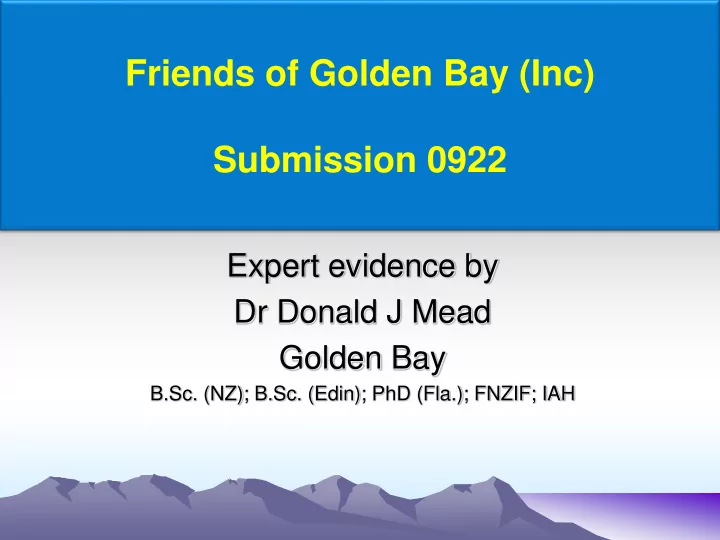

Friends of Golden Bay (Inc) Submission 0922 Expert evidence by Dr Donald J Mead Golden Bay B.Sc. (NZ); B.Sc. (Edin); PhD (Fla.); FNZIF; IAH
The sacred Te Waikoropupū Main Spring with exceptional clarity and very high ecological values
Inside the Arthur Marble Aquifer Photo Neil Silverwood Inside the Arthur Marble Auifer
Updated Friends of Golden Bay results Nitrate-N in the Main and Fish Springs (FoGB data) 0.50 0.45 Legend Nitrate-N (mg/l) Main NO3-N Fish NO3-N 0.40 Lowess (Main NO3) Lowess (Fish NO3) 0.35 0.30 1/12/15 1/3/16 1/6/16 1/9/16 1/12/16 1/3/17 1/6/17 1/9/17 1/12/17 1/3/18 Date • Lowess ( LO cally W eighted S catterplot S moothing ) explains 72 and 71% of the variation for the Main and Fish Springs, respectively.
Updated statistical results • Seasonal changes – Main Spring - not significant – Fish Spring - highly significant; lowest in summer & highest in winter • Sudden increase by 0.04 mg/l in March 2017 (10% increase) – Statistically a highly significant change •
• March 2017 increase : – Very highly significant ( P <0.0000) but means and standard deviations have hardly changed from the earlier submission. Median (mg/l N) Mean (mg/l N) SD (mg/l) Main Spring 0.395 0.395 0.0169 Before 19/3/17 After 19/3/17 0.440 0.442 0.0133 Fish Spring 0.360 0.362 0.0246 Before 19/3/17 After 19/3/17 0.400 0.408 0.0228
Updated – also uses Stewart’s new analysis • This analysis assumes the simple shallow/deep aquifer model is realistic. • Gives a feel of where the nitrate is coming from. Pre mid-March 2017 Post mid-March 2017 Shallow aquifer Deep aquifer Shallow aquifer Deep aquifer Nitrate-N (mg/l) 0.350 0.401 0.396 0.457 Nitrate-N (t/year) Fish Springs 30.7 9.0 34.7 10.0 Main Springs 26.2 97.0 29.6 108.3 Total 56.9 106.0 64.3 118.3 % from shallow 35% 35% aquifer
Discussion and conclusions • Nitrate in Springs is increasing and has reached the limit suggested by NIWA • 35% of nitrate discharged from Springs comes from ‘shallow aquifer’ • This is based on the assumption that the simple Stewart and Thomas model is OK • If setting limits the sampling strategy must also be defined • In the paper I have suggested how the FoGB data may be used to decide on an efficient sampling strategy
Nitrate-N in the Eastern Valley Creeks Median Range Nitrate-N (mg/l) Nitrate-N (mg/l) 0.03 – 0.04 Ironstone Creek 0.03 0.06 – 0.11 Gorge Creek 0.09 0.41 – 0.45 Rameka Creek 0.44 0.10 – 0.36 Small Spring 0.23 <0.001 – 0.028 Takaka River at Harwood* 0.005 * Based on data from 2005 to 2015 . There is already a 50 fold increase in nitrate from land-use
The Spring’s Phosphate (DRP) results • The median DRP is 0.005 mg/l for both Springs • Range 0.003 to 0.008 mg/l • Takaka river at Harwoods 2005-2015 • Median 0.0015 mg/l (range <0.001 – 0.003) • The AMA is being contaminated by P • Dissolved Reactive Phosphate in the Main and Fish Springs since February 2016 0.010 0.008 Legend DRP (mg/l) 0.006 Main P Fish P Lowess (Main P) 0.004 Lowess (Fish P) 0.002 0.000 1/12/15 1/3/16 1/6/16 1/9/16 1/12/16 1/3/17 1/6/17 1/9/17 1/12/17 1/3/18 Date
Fish Creek results • Samples collected at the reserve boundary • NO 3 – N and DRP wash off dairy farms – a wider problem than just Fish Creek. Nitrate-N and DRP in Fish Creek since February 2016 0.5 0.25 0.4 0.20 Creek NO3-N (mg/l) Creek DRP (mg/l) Legend 0.3 0.15 NO3-N DRP 0.2 0.10 0.1 0.05 0.0 0.00 1/12/15 1/3/16 1/6/16 1/9/16 1/12/16 1/3/17 1/6/17 1/9/17 1/12/17 1/3/18 Date
E. coli in Fish Creek • Sampled on 23 occasions since Nov 2016 and at several points in the catchment. • Initial study confirmed DOCs earlier results that E. coli is not in the Main Spring itself. • E. coli can be very high (e.g. >24000 /100 mm) on occasions. – depending on dairy cattle grazing patterns • This study is indicative of a widespread problem.
E. coli changes during a rain event
Discussion and Conclusions The National Policy Statement for Freshwater Management states that water quality must be maintained or improved • Nitrate-N has increased in both Springs over the 27 months • It is now at 0.44 mg/l – This therefore should be the upper limit for NO 3 - N • The median PRP is 0.005 mg/l. – This is substantially higher than measured at Harwood’s on the Takaka river. – The upper limit for DRP should be 0.005 mg/l
• Nitrate, phosphate and E. coli wash off pastures into streams and rivers – These also need to be addressed by the Tribunal
Thank You
Recommend
More recommend